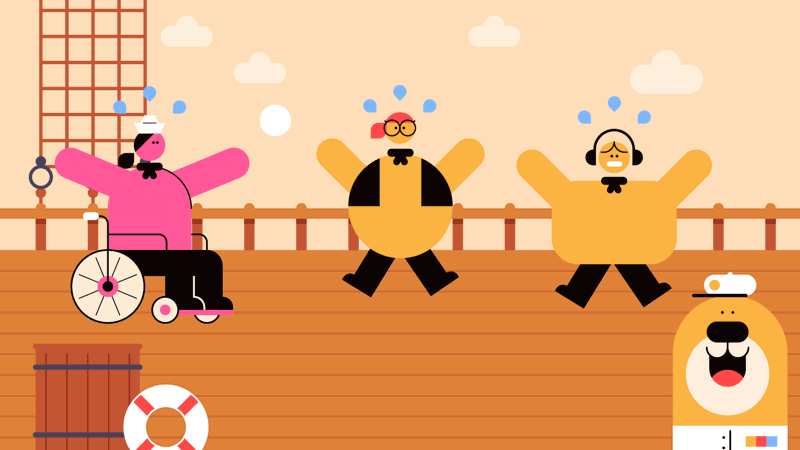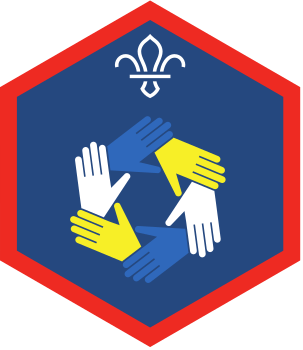
Play Captain’s Coming
You’ll need
- Space to run around in
Before you begin
- Use the safety checklist to help you plan and risk assess your activity. There's also more guidance to help you carry out your risk assessment, including examples. Don’t forget to make sure all young people and adults involved in the activity know how to take part safely.
- Make sure you’ll have enough helpers. You may need some parents and carers to help if you’re short on helpers.
To watch in full screen, double click the video
Learning the game
- One member of the group is the Captain. This person will call out the commands. It could be a young member, young leader or adult volunteer.
- Everyone else should stand in the centre of the space, ready to respond to the commands with the appropriate action.
- Everyone should practice the Captain’s commands. Read them out one at a time and show everyone the action. Let them have a practice.
- You could choose a selection from or all of the following:
-
- Bow – Run to the front of the space
- Stern – Run to the back of the space
- Port - Run to the left of the space
- Starboard - Run to the right of the space
- Captain's coming! - Stand completely still and salute.
- Hit the deck - Lie down on your stomach
- Climb the rigging - Pretend to climb rigging.
- Person overboard – Hug the person next to you
- Scrub the deck - Kneel down and pretend to scrub the floor
- Cannonballs - Crouch on floor with hands over head
- Dig for treasure – Mime digging a hole
- Seagulls - Flap your arms like a bird
Playing the game
- Once everyone knows the commands, play the game.
- You could also add in more actions as you go to make the game harder.
- You could start to get faster to make it harder and play it so the last person to do the action is out.
- Alternatively, if you want to people to become out as you play the game, you could add in these actions:
-
- Lifeboats (2, 3, 4, 5) - Players must get into a group of that number of people as quickly as possible. For example, for the command 'Lifeboats three!', players must get into groups of three. Anyone without a group or with a lower number in their group could be out.
- Sharks - Everyone must run to a designated base. The last player to the base is out.
Winning the game
- The person left at the end of the game is the winner.
- If you want to do a longer warm up, or simply want to play again, play another game and change who the Captain is.
- You could also ask people to create a new action and add it in, or add in another action you haven't used from the lists on this page.
Taking it to the next level
For anyone working towards Stage 3 of their Sailing Staged Activity Badge, or wanting a harder version of the game, you could add in some extra nautical terms:
Meaning: anything towards the back of the boat.
Action: lie on your back.
Meaning: anything towards the front of the boat.
Action: lie on your front.
Meaning: where you steer the boat. There’s usually a wheel or tiller to control the boats rudder.
Action: put your arms behind your back and move them left to right.
Meaning: a long heavy fin on the bottom of the boat that sticks down into the water.
Action: crouch down and put your arms above your head, with your hands clasped together.
Meaning: the big triangular sail just aft of the boats mast. It’s the largest and most important sail.
Action: find a partner and use your arms to make a triangle.
Meaning: another common sail on a boat, found forward of the mast.
Action: stand still and put your arms in an ‘L’ shape to make a sail.
Meaning: the side of the boat furthest from the wind.
Action: freeze and be as still as you can, like a tree without any wind.
Meaning: the side of the boat closest to the wind.
Action: stand on one leg and pretend to wobble, like you're caught in the wind, but don't let your lifted foot touch the ground until the next action's called.
Meaning: to change direction by turning the bow of the boat through the wind.
Action: run to the bow, stand on one leg and hop around in a circle, but don't let your lifted foot touch the ground until the next action's called.
Meaning: another way to change direction, by turning the stern of the boat through the wind.
Action: run to the stern, stand on one leg and hop around in a circle, but don't let your lifted foot touch the ground until the next action's called.
Meaning: the boat’s direction relative to the wind.
Action: freeze and point in any direction.
Meaning: when the wind is blowing from the port side of the boat.
Action: run to the port side and wave your arms like you're the wind.
Meaning: when the wind is blowing from the starboard side of the boat.
Action: run to the starboard side and wave your arms like you're the wind.
Reflection
This activity was about being active and having fun, as well as warming up our muscles. Why do you think it’s important to warm up your muscles, especially before doing a physical activity?
If you used the nautical terms, do you think this would be a good way to warm up before going sailing? Why - did you learn any new sailing terms during the game that could be useful when you’re out on the water? Can you think of any other good ways to warm up before a session of sailing?
Safety
All activities must be safely managed. You must complete a thorough risk assessment and take appropriate steps to reduce risk. Use the safety checklist to help you plan and risk assess your activity. Always get approval for the activity, and have suitable supervision and an InTouch process.
- Active games
The game area should be free of hazards. Explain the rules of the game clearly and have a clear way to communicate that the game must stop when needed. Take a look at our guidance on running active games safely.
- Introduce the commands at a pace suitable for the group.
- If the names of the boat (bow, stern, port and starboard) are new to the group, label the playing space with them.
- Adapt the actions to suit your group. For example, pointing or shouting the direction instead of running towards it.
- If someone may struggle to play the game, they could call out the commands.
- Change the actions or select actions that everyone can do, so everyone can join in.
- If some people may struggle to do the actions quickly, you could play the game so that no-one goes out.
- A young leader or adult volunteer could stand by the caller and do the actions to help everyone remember, too.
- No-one has to hug, or be hugged, if they don’t want to. Make sure everyone is comfortable to do this or you could use an alternative action.
All Scout activities should be inclusive and accessible.
To make it even harder, you could try playing the game in French with Le captaine arrive.
You could challenge the group to come up with their own commands, too.



